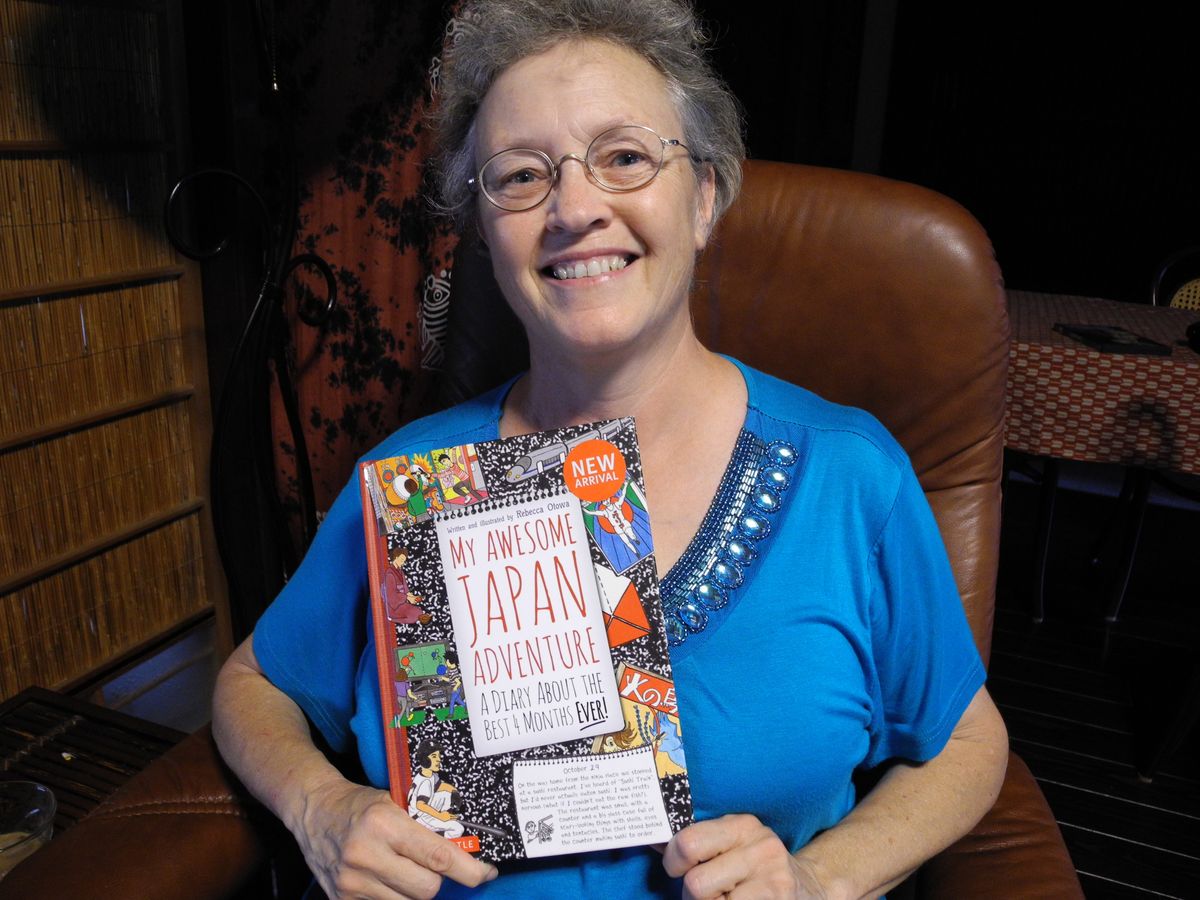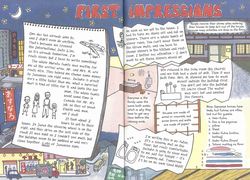November 19, 2013
Rebecca Otowa on Crafting “My Awesome Japan Adventure”
By Avery Fischer Udagawa
Rebecca Otowa authored the memoir At Home in Japan: A Foreign Woman’s Journey of Discovery (Tuttle Publishing, May 2010), which led to a review in SWET Newsletter No. 124, available online to members, and a speech described in No. 126. Otowa has now released a second book, this time for children. My Awesome Japan Adventure: A Diary about the Best 4 Months Ever! (Tuttle Publishing, November 2013) (Amazon.com link) is the fictional diary of an American fifth grade boy who visits Japan on exchange. Otowa wrote and illustrated the boy’s diary plus supplemental, guidebook-like sections that interweave with his narrative. Otowa responded to an e-interview for SWET about the process of crafting My Awesome Japan Adventure.
Q. What gave you the idea to publish a book about a fifth grade boy visiting Japan?
 A. I worked on a children’s book about Japan at the suggestion of Tuttle. They wanted to see what I could do with a children’s book after seeing the illustrations I did for the original version of At Home in Japan, my first book. The editors and I considered several formats. Finally, the CEO of Tuttle, Eric Oey, suggested that the story be told in the actual voice of a child. From there the transition to the diary format was easy.
A. I worked on a children’s book about Japan at the suggestion of Tuttle. They wanted to see what I could do with a children’s book after seeing the illustrations I did for the original version of At Home in Japan, my first book. The editors and I considered several formats. Finally, the CEO of Tuttle, Eric Oey, suggested that the story be told in the actual voice of a child. From there the transition to the diary format was easy.
Q. Did you have any models for Dan, the main character, or for other characters?
A. Not really. I like age 10 or 11; it was one of my favorite times with my own two sons. But Dan isn’t based on any real-life person. I wanted Dan to have a same-age playmate in the host family, and I also thought it would be good to have a girl in the family, thus attracting children of both sexes to read the book. Actually Dan’s family is the same configuration as his host brother’s—two parents, one son, and one younger daughter. This creates possibilities for the two younger sisters to connect about their hobbies by email.
Q. Tell us about your decision to set the book in a small town near Kyoto.
A. There seem to be a lot of “introducing Japan” books based on Tokyo. I was interested in providing some balance for that. Tokyo, it can be argued, is a law unto itself, and it’s very different from other parts of Japan. Setting Dan’s homestay in a rural area gave me scope to address some topics not so much related to Tokyo, such as farming, history, and traditions. Plus, it’s the area I know best, so it was easy to write about.
Q. My Awesome Japan Adventure overflows with color, with more than half of each spread rendered in vivid watercolor. Why did you choose a graphic fiction format over typeset text with illustrations?
A. Since Tuttle gave me carte blanche with the page design, I thought I’d go all out with color, patterns, different title styles, etc. I deeply love color and think most children do, too. I believe it hooks the interest like nothing else can. Also, the comic-like look of it suits my drawing style. I really enjoyed seeing how visually different I could make each spread.
Q. Indeed, each of the 24 spreads has a distinct layout. You combine hand-written diary entries with illustrations of Dan’s trip and facts delivered in captions, thought bubbles, diagrams, and even emails. Tell us how this design evolved.
A. Although Dan’s is the main voice in the book, it seemed to me that additional material would be necessary to flesh out his observations—he couldn’t be expected to know everything about what he experienced. So I added an impersonal voice in the form of bubbles and captions. I included a couple of emails from Dan to his family back home to give the book a contemporary feel. Other than that, each page spread evolved separately by itself. I did a rough version of each spread in colored pencils and submitted that to my editor for approval (spacing, content, etc.) before embarking on the final watercolor version. 
Q. Did the book first come to you as images, as a narrative, or as a series of topics to explore? How did you reconcile its journal and guidebook aspects as you wrote?
A. When I was asked to do the book, the first thing I did was make a list of possible topics. This was tweaked several times. Over the course of time the idea of the homestay developed, and this gave me a good frame for the topics. Since Dan was to be in Japan from September to January, the things he would experience were largely tied to those months. As for the journal versus the other material, I usually began my writing with the journal. I imagined Dan in the various situations, and thought about what he would see, hear, and (often) taste, what he would find especially strange or interesting, etc. When the journal entry was written, I started adding information I thought would round out the topic for the reader. It was actually a challenge for me to remember I was writing for children, and avoid giving too much information.
Q. Children abroad often have seen origami, heard of ninjas, or eaten sushi. But your book invites them to fold paper flowers themselves, investigate real ninja tools, and name the types of sushi. Tell us about your interest in taking children’s knowledge of Japan a step further.
A. I have experience of primary school teaching in Japan, and I know that learning is most effective, and fun, when it involves the whole body. The activities in the book will, I hope, provide a little hands-on experience of how it feels to be Japanese, creating more impact and hopefully a desire to explore further. Also, as a teacher, I know the value of keeping things just a little over the kids’ heads. Even if they don’t understand everything, their curiosity is piqued. Finally, one of my mottoes is “God is in the details.” Any book is more interesting if you add details, especially sensory details.
Q. Your book encourages readers to try “challenges” such as writing Japanese characters. Other introductions to Japan for children might steer readers away from such “difficult” tasks. Were you hoping to alter some stereotypes about “inscrutable” or “complex” Japan?
A. This never entered my head. I think it is more a case of offering challenges, which most kids really appreciate. This is why I named the activities “challenges.” There are several different ones in the book for different personalities. It isn’t necessary to do every activity 100 percent—they are optional. Some kids will gravitate towards cooking, others towards writing. The idea of having activities in the book was adopted very early on. I think the ones we kept represent a nice mix of possibilities for experience.
Q. In the acknowledgments, you mention a Japanese primary school, two museums, and your family and neighbors. Did the book require extensive research? Did you learn new information by creating it?
A. Many of the page spreads required trips to take photographs, which I then copied in simplified form—especially the trip to Osaka, the children’s calligraphy lesson, the ninja village, and the rice harvest. Otherwise, I mostly just wrote what I know. A lot of the scenes are from my own house, such as the mochi spread—we still make mochi in the traditional way every year. The primary school that appears in Dan’s “First Week of School” spread is where I work, and also where my own kids went to school—I thought they would be tickled to be mentioned in the acknowledgments. I did learn quite a few new things about my corner of Japan.
Q. How did you select topics to cover, from bowing and New Year rituals to Toppo candy?
A. Tuttle and I worked on this together. My initial list of topics left out a good many things they wanted to have included. As I mentioned, having the homestay’s time limit provided a useful frame for topics, since seasonal activities in Japan are so clear-cut. The last spread, “Next Time,” shows some of the topics on the list that didn’t make it into the book, largely because of the page limit—for example, paper, armor, and musical instruments.
Q. The final spread hints at many more enticing topics to explore. Will there be a sequel?
A. I would be thrilled if My Awesome Japan Adventure were successful enough to demand a sequel, and it would be a lot of fun to do a spring version. Of course, we would have to address the question of whether Dan is going to get older—by the time he returned to Japan he might well be 13 or 14!
Q. What is your favorite onigiri filling?
A. I like salmon flakes best; next, kimchi.
(Interview originally compiled for the SWET website, November 2013)
© Avery Fischer Udagawa and Rebecca Otowa
